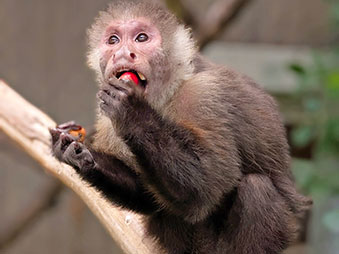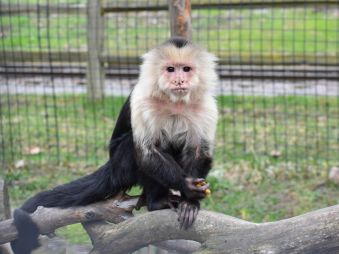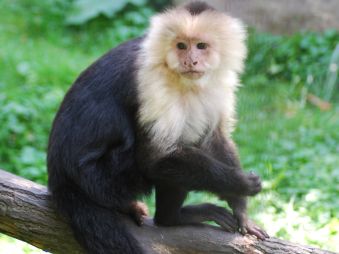Cebus capucinus | White-Throated Capuchin
Names: Mouka and Tyke (Males)



Meet Mouka and Tyke
Say hello to Mouka and Tyke, two White-Throated Capuchins who call our zoo home. Native to the neotropical forests of Central America, these agile primates are as clever as they are curious. Known for their intelligence, dexterity, and strong social bonds, capuchins are often considered the brainiacs of the New World monkeys.
Equipped with opposable thumbs, partially prehensile tails, and strong molars, they're perfectly built for life in the trees—climbing, foraging, and cracking open tough nuts. At the zoo, Mouka and Tyke enjoy a nutritious diet of New World primate biscuits, leafy greens, vegetables, seeds, nuts, insects, and a small amount of fruit, which mirrors their wild menu of fruits, nuts, insects, and small animals.
Life in the Treetops
White-Throated Capuchins are arboreal, meaning they spend nearly all of their lives in the treetops. Their social lives are just as elevated—both literally and figuratively. From grooming rituals to organized, single-file travel, these monkeys live in complex societies built on trust, communication, and cooperation.
They communicate through vocal calls, facial expressions, and physical touch, sharing information and reinforcing group bonds. And while their sense of smell isn't highly developed, they use a behavior called urine-washing—rubbing urine on their hands and feet—to mark territory and navigate their environment.
Smart, Social, and Strong
Capuchins have long fascinated researchers due to their impressive intelligence and problem-solving skills. In the wild, they've been observed using tools like sticks, stones, and leaves to gather food or interact with their surroundings. This adaptability helps them thrive in changing environments.
White-Throated Capuchins are also sexually dimorphic, with males being larger than females. They're polygamous, meaning both males and females may have multiple mates. Within groups, a dominant male typically leads, protecting the troop and securing most breeding opportunities. While males play a limited role in infant care, females are the primary caregivers, especially during early development.
In the wild, capuchin groups typically consist of 18–20 individuals, with females remaining in their birth groups—a behavior known as philopatry. Males usually leave around age four to seek out new social groups.
These monkeys are diurnal, meaning they're active during the day and rest at night. Mouka and Tyke reflect all of these traits, spending their days exploring, problem-solving, and engaging with enrichment activities that keep their minds and bodies active.
Important to the Ecosystem
Beyond their brains and charm, White-Throated Capuchins play a vital ecological role. As they travel and feed, they help disperse seeds throughout the forest, supporting plant regeneration and forest diversity. Thanks to their active lifestyles and varied diet, they're considered excellent seed dispersers—helping to maintain the health of their natural habitats.
Fact Sheet
Taxonomy
Genus: Cebus | Species: capucinus
Kingdom: Animalia | Phylum: Chordata | Class: Mammalia | Order: Primates | Family: Cebidae |
Favorite Enrichment Type
Socks, t-shirts, mirrors, blankets, sippy cups, fresh herbs, hanging logs, fabric ladders, cargo nets, and bird videos/sounds.
Diet
- In the Wild: Omnivorous, earing fruits, nuts, insects, and small animals.
- At the Zoo: New World primate biscuits, greens, vegetables, seeds, nuts, insects, and a small amount of fruit.
Life Span
- In the Wild: 25 to 30 years old
- In Human Care: 45 to 55 years old
Geographic Range
The Neotropical Region of Central America, which includes Honduras, Nicaragua, Costa Rica, Panama, and the coast of Columbia and Ecuador.
Habitat
They can be found in a large range of habitats, including primary and secondary forests that are both dry and wet, but they prefer dry deciduous and tropical evergreen forests.
Fun Facts About White-Throated Capuchins
- Tool-users in the wild: Capuchins have been observed using sticks to dig for insects, stones to crack open nuts, and leaves as makeshift cups to scoop water—clear signs of their intelligence.
- They solve problems together: These monkeys often work in teams to access food, defend their territory, or care for young. Their cooperative behaviors highlight their complex social intelligence.
- They practice “medicinal” fur-rubbing: In the wild, capuchins rub their fur with substances like citrus fruits, millipedes, or specific plants believed to have insect-repelling or antimicrobial properties—thought to be a natural form of pest control.
- Long childhoods = lots of learning: Capuchins have extended juvenile periods compared to many other monkeys. This gives young individuals more time to learn key survival skills like tool use, foraging, and social navigation by watching and mimicking adults.
Status: Vulnerable
Not a Pet
Despite their small size and expressive faces, White-Throated Capuchins do not make good pets. These wild animals require complex diets, specialized veterinary care, constant enrichment, and social interactions that cannot be replicated in a home. When kept as pets, capuchins often develop serious behavioral issues and can’t safely return to the wild once they’ve been imprinted on humans.
Unfortunately, the illegal pet trade and ongoing habitat destruction continue to threaten wild populations. That’s why ambassadors like Mouka and Tyke play such an important role—reminding visitors that protecting natural habitats and saying no to exotic pets are vital steps in wildlife conservation.
To learn more about why capuchins and other primates aren't suited for life as pets, be sure to visit the Not-a-Pet Campaign.
How to Find Us
You can find Mouka and Tyke romping around their habitat located right after the Outback Aviary, before you cross over the bridge. Take a minute to appreciate their BIG personalities and agile movements from branch to branch.
